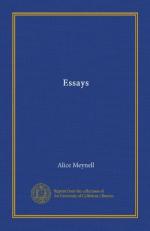are enough? Now Impressionists have told us
things as to their impressions—as to the
effect of things upon the temperament of this man and
upon the mood of that—which should not
be asserted except on the artistic point of honour.
The majority can tell ordinary truth, but should not
trust themselves for truth extraordinary. They
can face the general judgement, but they should hesitate
to produce work that appeals to the last judgement,
which is the judgement within. There is too much
reason to divine that a certain number of those who
aspire to differ from the greatest of masters have
no temperaments worth speaking of, no point of view
worth seizing, no vigilance worth awaiting, no mood
worth waylaying. And to be,
de parti pris,
an Impressionist without these! O Velasquez!
Nor is literature quite free from a like reproach
in her own things. An author, here and there,
will make as though he had a word worth hearing—nay,
worth over-hearing—a word that seeks to
withdraw even while it is uttered; and yet what it
seems to dissemble is all too probably a platitude.
But obviously, literature is not—as is
the craft and mystery of painting—so at
the mercy of a half-imposture, so guarded by unprovable
honour. For the art of painting is reserved that
shadowy risk, that undefined salvation. If the
artistic temperament—tedious word!—with
all its grotesque privileges, becomes yet more common
than it is, there will be yet less responsibility;
for the point of honour is the simple secret of the
few.
THE COLOUR OF LIFE
Red has been praised for its nobility as the colour
of life. But the true colour of life is not
red. Red is the colour of violence, or of life
broken open, edited, and published. Or if red
is indeed the colour of life, it is so only on condition
that it is not seen. Once fully visible, red
is the colour of life violated, and in the act of betrayal
and of waste. Red is the secret of life, and
not the manifestation thereof. It is one of
the things the value of which is secrecy, one of the
talents that are to be hidden in a napkin. The
true colour of life is the colour of the body, the
colour of the covered red, the implicit and not explicit
red of the living heart and the pulses. It is
the modest colour of the unpublished blood.
So bright, so light, so soft, so mingled, the gentle
colour of life is outdone by all the colours of the
world. Its very beauty is that it is white,
but less white than milk; brown, but less brown than
earth; red, but less red than sunset or dawn.
It is lucid, but less lucid than the colour of lilies.
It has the hint of gold that is in all fine colour;
but in our latitudes the hint is almost elusive.
Under Sicilian skies, indeed, it is deeper than old
ivory; but under the misty blue of the English zenith,
and the warm grey of the London horizon, it is as
delicately flushed as the paler wild roses, out to
their utmost, flat as stars, in the hedges of the
end of June.




